
CPU coolers compared, page 9 - Pentium 4 coolers
Review date: 26 May 2001.Last modified 03-Dec-2011.
The Intel Pentium 4 CPU needs a big fat cooler, because its heat output is up there with that of the faster Athlons. But the P4's much harder to damage, or even just cause to crash, if you use a lousy cooler, or even none at all. The P4's thermal throttling feature lets it drop its speed when it gets too warm. So under-cooled P4 systems may be a lot slower than they should be, but there's a good chance that they'll keep running, and the CPU won't be smoked.
Now that Socket 478 P4s are commonly available and prices have dropped, the overclocking community's actually becoming interested in something besides Athlons and Durons. The P4 still doesn't provide the same bang per buck as the AMD CPUs, but it's not nearly as crazy an option as it used to be, and the Socket 478 standard should be with us for a while, which is more than can be said for the original Socket 423 standard.
Even base model P4 coolers shift heat to the air better than practically all air coolers for Socket A or Socket 370 processors, because all P4 coolers have a bigger footprint, and all P4s have a much bigger contact patch than current high performance CPUs for the other sockets. Most P4 coolers also have a 70mm fan on them, because that's how wide their heat sink is; that gives them better than four-thirds of the fan area, all other things being equal, and so even low profile fans can work pretty well as they blow on that great big heat sink.
The world isn't exactly crawling with after-market Socket 423 coolers, though, and there are even fewer high performance Socket 478 ones out so far. Here are a few.
Stock Intel Socket 478 cooler
Here's what came with the 1.7GHz Socket 478 Willamette-core P4 which I checked out on an i845-chipset motherboard here. Intel are known for changing their cooler designs quite often, but they generally provide pretty good units. Intel coolers always have quiet low-profile fans and all-aluminium heat sinks; taking that into account, they generally deliver quite acceptable performance. In fact, a stock Intel cooler used with a smear of thermal grease instead of the thermal pad they usually come with can significantly beat many of the lousier after-market coolers.
This cooler attaches in the standard Socket 478 way; there's a frame around the CPU socket onto which you somewhat awkwardly clip the top frame of the cooler, with the heat sink sandwiched in between. Then you move the two lever arms over to the locked position, and the bases of the levers use cam action to jam the heat sink down hard on the processor.
Very hard on the processor.
So hard on the processor, in fact, that this cooler did this...
...to the poor Asus P4B i845 board I tried it with.
It is alleged that Intel have tried to convince people that bending the bejaysus out of their motherboard is a good thing, because if something smacks the computer then the CPU socket's less likely to pop off the board.
Seriously.
The rest of the world's been making do with coolers that don't compress the CPU die into neutronium for rather a while, though, so I remain unpersuaded.
These coolers don't actually break anything, at least in the short term. They just look as if they ought to.
Not every cooler using the four-hooks, two-levers retention scheme squeezes the life out of the CPU, but they all seem to be a bit annoying to unhook after you unlock them. The hooks just don't want to let go, and the stiff upper frame can be tricky to unclip. Compared with the dodgier screwdriver-assist clips on Socket 370 and Socket A coolers, though, this system is a dream.
I didn't have a proper P4 cooler test jig when I tested this cooler, so I just wired it down onto my standard socket rig, and made a new copper contact patch simulator to match the much larger contact patch that the P4 offers. The smaller Socket 478 P4 actually has a slightly larger contact patch than the big old Socket 423 model, by the way.
The questionable cooler attachment method may have influenced the results I got, but I doubt it hurt them; thanks to its large heat sink and contact patch, this basic cooler scored very well compared with the smaller-contact-patch coolers for other socket CPUs. It clocked a highly respectable 0.53°C/W; excellent, considering its quiet fan and get-it-with-your-boxed-CPU price.
0.53°C/W is up there with the finest of the exotic coolers for the other socket form factors, but if you shoehorned this cooler onto your Athlon, it wouldn't do that well. Small contact patches aren't a great thing when your heat sink's all aluminium. Plus, it's just physically impossible to get a cooler this big onto a lot of non-P4 motherboards, regardless of any ingenious hold-down method you might devise to get around the problem of actually attaching it. You wouldn't get that far, because the heat sink would just foul capacitors around the socket.
But, with the hefty contact area which all P4s offer, this stocker is a worthwhile cooler.
Performance like this from a stock cooler, plus the fact that P4s just slow themselves down if they're running too hot (which is very considerate of them; check this out to see the alternatives...), strongly suggests that going bananas about your P4 cooling isn't likely to get you much of a return. A quite modest P4 cooler will still be a big melonpicker compared with a stock Socket 370 or Socket A one, and will have a bigger fan, and will have a bigger contact patch, and will thus probably perform acceptably well even if you're overclocking.
If your cooler isn't up to scratch and your CPU throttles itself and slows down, then you can spend money on a better cooler. You don't need to get one up front. Which is a nice thing to know, if you've just blown your gadget budget on the more expensive Intel CPU.
Aerocool Hercules
The Hercules is Aerocool's "dual fuel" cooler. It's got a simple screwdriver-attach one-piece spring-clip that lets you install it on Socket A systems, but the aluminium frame over the thin-fin solid copper heat sink also has running boards at the ends, which are there to accept Socket 478 mounting clips. The cooler's topped off by a medium power 70mm translucent fan, allowing you to see as much of the copper you paid for as possible.
You get two Socket 478 clips, and a four pin power adapter for the fan, in the Hercules's fancy see-through box.
The Hercules' heat sink has a near mirror finish base which is rather flatter than the bottom of their other solid-copper sinks. In Socket 478 mode, the Hercules scored an entirely acceptable 0.51°C/W. Which isn't remarkable, but is more than enough to do the job.
As I said in my review of this cooler in Socket A mode (which, you might notice, shares quite a few words with this review of it here), I don't really know who's supposed to be excited by the concept of a cooler that fits on both Socket A and Socket 478. Computer hardware store owners, maybe, who can stock one item to suit both kinds of processor. From a consumer's point of view, it's not much of a selling point.
That said, though, this is a perfectly OK Socket 478 cooler; never mind the extra clip sticking out of it. Buy it with confidence.
In case you missed them on the other page, by the way, here are the boxes in which Aerocool provide their fancier coolers, including this one (the Hercules is on the left).
The boxes may persuade you to buy by themselves.
AVC Sunflower
Another Socket 478 cooler, but a rather more stylish one than the Intel effort.
The most interesting thing about the Sunflower, and the source of its name, is its copper-cored forged-aluminium heat sink...
...which is rather cute, if you ask me.
Apart from this impressive fin-spiral around the shiny copper cylinder, the Sunflower's similar to the standard Intel Socket 478 cooler. It attaches with the same sort of swinging-lever apparatus, though it doesn't clamp down as frighteningly as the stock sink I played with. In case your Socket 478 motherboard didn't come with a CPU retention frame, the Sunflower includes one; the four little hooks that hold it onto the frame are, again, a bit tricky to disengage if you want to take the cooler off.
The Sunflower's fan is a 70mm unit, normal for P4 coolers, but it's more powerful (and louder) than a stock cooler.
The extra noise and the fancy heat sink achieve something. This cooler scored an excellent 0.47°C/W. If you're looking for an attractive Socket 478 cooler with imposing performance, this is the best I've seen so far.
Bitspower NP478S
A Socket 478 cooler done the Bitspower way, with a skived aluminium heat sink (fins peeled up from a block of solid aluminium by a blade; it's one of those industrial processes that obviously can't work, but does). Atop the heat sink sits a modestly powerful fan - actually, it's exactly the same Everflow R127015DU, in exactly the same frame, as the Ideal Elethermal ABAF-P4-478-1 reviewed below uses. There's a Bitspower sticker on top; that's the extent of the difference.
The NP478S's retention clips (not included in the above picture) are longer than usual, to accommodate the taller and oddly offset skived sink. But, like most Socket 478 coolers, this is still an easy device to attach, and uses the standard plastic mounting frame. The heat sink's a little fragile, but it's not a big deal.
Ideal Elethermal don't manage to get a fabulous amount of performance out of their Socket 478 effort, but Bitspower do better with the same fan. The NP478S scored a quite respectable 0.50°C/W.
That's not a score worth declaring a national holiday over, and it's not enough better than a stock cooler that there's any point paying for the upgrade. But this should still be a perfectly all right cooler for fast Northwood P4s, including overclocking applications.
Bitspower's products are generally competitively priced, despite their unusual heat sink technology, so the NP478S ought to be a good buy.
Cho-Liang P4CB0307Z-17
Cho-Liang's P4CB0307Z-17 is their entry in the "P4 cooler that looks like everybody else's P4 cooler" stakes. It's got a completely conventional rectangular vertical-fin aluminium heat sink, retained with a couple of separate hinged spring clips that work fine but won't win any design awards, and topped by the same 70mm fan as the three other coolers Cho-Liang sent me (one P4, two Socket A).
The fans on the other three Cho-Liangs behaved themselves perfectly well, but this one sounded a bit sick; its speed and power consumption fluttered a bit, presumably because of a mild bearing problem which, over time, might become an un-mild bearing problem. This fan still averaged out at the same power consumption as the one on the CN0309Z-17, so it wasn't too bad, but I wouldn't be surprised if it died young.
Of the four Cho-Liang fans, the two on the P4 coolers each consumed about 2.6 watts at 12 volts once they'd spun up; the ones on the other two coolers scored about 2.65 watts for the one on the copper CB0315U-17, and about 2.8 watts for the one on the copper-look CB0307U-17. That's a spread of less than 8% in run power, which isn't indicative of particularly flaky quality control. All of the fans started spinning from less than three volts, by the way, which means they may be good candidates for reduced-voltage silent-computing applications.
The only vaguely notable thing about the P4CB0307Z-17's design is that the heat sink fins are of different heights, so the sink's cross-section has a wavy top. This is a turbulence-reduction trick that's been used on quite a few heat sinks now, and it probably has something to do with the fact that this simple cooler scored 0.48°C/W. Which is pretty good, and should make this cooler a reasonable choice for P4 overclockers who aren't looking for a flashy heat sink.
Cho-Liang CN0309Z-17
Looking not unlike a somewhat lower rent version of the AVC Sunflower, Cho-Liang's CN0309Z-17 is another Socket 478 cooler with a couple of cam-lock arms to make mounting easy, and a radial-fin heat sink.
The sink's solid aluminium, with no copper core, but the tower up the middle of the sink should still give it decent performance, providing a reasonably low thermal resistance path to most of the fin area. The core tower is topped with stubby square pins, but they're really just decorative; the medium-low-noise low profile 70mm fan directs almost all of its air down over the fins proper.
The trouble with straight radial fin coolers like this is that they just don't have that much fin area, though, which could explain the CN0309Z-17's 0.51°C/W performance. Better than stock, and better than most P4 owners are every going to need, yes. Thrillingly effective, no. But if you're looking for an attractive Socket 478 cooler with entirely acceptable performance and a no-fuss retention mechanism, and you can get a CN0309Z-17 locally, by all means buy it. It's a perfectly sound product.
Coolink Cool Tank Breeze
The Pentium 4 heat sink form factor is made for 70mm fans, so squeezing an 80mm one on isn't too hard. Why, exactly, you'd want to do that might not immediately be clear. Moderate-power 70mm fans generally seem to do just fine at cooling overclocked P4s as much as is needed.
If you're interested in quiet computing, though, a bigger and taller fan can move as much air as a smaller one, with less noise. And a thermally controlled 80mm fan has further advantages over a fixed-speed 70mm one in the noise department.
Coolink's Cool Tank Breeze is sold by PC Range here in Australia for $AU36, plus $AU8 for Australian shipping. It has a neat looking aqua-and-clear translucent 80mm full-height fan wired to the top of it, and that fan spins faster when the heat sink's hotter.
You can see the thermal probe tucked into its hole in the side of the heat sink in this picture - and you can also see that the bottom of this all-aluminium sink is, unusually, very highly polished. It's pretty decently flat, too, so it ought to get about the best thermal contact with your CPU you can expect from an aluminium sink.
The Breeze's retention mechanism is a simple pre-installed clip system that doesn't make you fiddle with separate springs. It's nothing revolutionary, but it works.
With the heat sink chilled close to freezing, the Breeze's fan draws about 60 milliamps (mA) at 12 volts, for about a 0.72 watt run power. At that speed it's not actually as dead quiet as you'd think, because the fan motor's having a hard time kicking over. At normal room temperatures it spins a bit faster and will be pretty much inaudible, if it's inside a computer case.
Heat up the sink and the fan spins faster. Its peak power is about 2.3 watts, and it reaches that power at about 40°C.
Now, 2.3 watts is only a medium-low power rating for an 80mm fan, and even at full speed this one doesn't make a racket. But you don't need a super-fan on a P4 cooler, and this fan's very quiet low-temperature operation should make this cooler interesting to people who want to make themselves a near-silent computer.
At minimum power, the Breeze scored an unexciting 0.56°C/W, but whaddayawant from something drawing so little juice. At full power, it managed a perfectly respectable 0.48°C/W, which should be more than enough for all but the nuttiest of overclockers.
For the money, this is a perfectly good cooler. It looks nifty, it works well, and unlike most P4 coolers, it's actually got a couple of unusual features.
Glacial Tech Igloo 3300
This is a Socket 423 P4 cooler. It comes with...
...the usual pair of clips to attach it to the Socket 423 motherboard retention thingummy, which is, of course, completely different from the newer Socket 478 one. Not even the frame holes are in the same place.
These clips look complicated but are actually easy to use; I don't mind the Socket 423 retention mechanism at all. As with Socket 478, the chance of trashing your motherboard as you fiddle with the clips is small.
The Igloo 3300 has a slightly noisier-than-stock fan and a much shinier-than-stock heat sink, but there's no copper insert or other fanciness. It scored the same as the stock cooler - a highly commendable 0.53°C/W.
So there's no reason to buy one of these instead of a stock Intel cooler - if you need more cooling for your P4, just replacing the thermal pad on the stock cooler with a grease-smear should do as much for the system as buying an Igloo 3300. If you've got an OEM cooler-less Socket 423 P4 and you're looking for a nice shiny hunk of aluminium with which to decorate it, though, there's nothing wrong with this one.
Glacial Tech Igloo 4300
Glacial Tech's Socket 478 cooler is a more exciting item than their Socket 423 one.
This cooler offers an alternating-fin-height all-aluminium heat sink with more surface area than the stock Intel cooler can manage, but its major feature...
...is its spiffy retention mechanism.
Instead of four separate plastic hook protuberances, the Igloo 4300 has this all-steel mechanical latch, which hooks onto a standard Socket 478 frame, but does so in a more elegant way than the usual one,
To lock the Igloo 4300 onto Socket 478, you attach its fan assembly onto the retaining frame hooks, as normal. It's distinctly looser when unlocked, because the latch gives it a lot of clamping range. This extra looseness makes it easy to remove, as well as attach.
Press the locking catch into place and the 4300 is firmly held down, without bending the motherboard. Nice and easy.
How's it perform? Pretty well. It scored 0.49°C/W. Which is not quite as good as the copper-cored AVC Sunflower, but is definitely down around the error margin of the test equipment. I doubt any overclocker would be able to hit a higher speed by using the Sunflower than by using the Igloo 4300.
Ideal Elethermal ABAF-P4-478-1
Light weight isn't a very important quality for P4 coolers. Since they mount on a frame attached to the motherboard, you won't damage the CPU socket if you use a hefty cooler.
All things being equal, you'd rather not have some ludicrous one-kilo copper monstrosity sitting on your CPU if your computer gets knocked over or dropped. But otherwise, the mass of the cooler matters little.
For what it's worth, though, Ideal Elethermal's ABAF-P4-478-1 only weighs 225 grams.
The reason for that is this thin-fin aluminium heat sink, using Everflow's "Clipped-Fin" design to get a massive surface area without using a ton of metal.
Surface area's not particularly useful if air can't flow past the fins easily, though, and these fins are pretty closely packed, with no cross-cutting to let air out of the sides of the sink.
You install this cooler by sitting the heat sink in the normal Socket 478 mounting frame, dropping the fan frame on top of the sink, then attaching a couple of quite elegant two-part clips.
The fan's a low profile 70mm Everflow R127015DU with a nominal 2.76 watt rating, though significantly lower run power, as usual. It's a medium power, reasonably quiet unit; no good for silent computing, but perfectly acceptable for an ordinary PC not owned by someone tolerant of tiny turboprop noises.
The ABAF-P4-478-1 scored an un-amazing 0.53°C/W when I tested it. I re-ran the test more often than usual to make sure I hadn't messed something up, but that was the score, all right. So it's not rubbish, but neither is it likely to be a step up from a stock Intel cooler, despite its groovy looking heat sink.
If you're buying an OEM P4 CPU with no cooler, this one's a perfectly good choice. It'll cool every stock-speed Socket 478 P4 that's available as I write this, and deal with some extra heat from overclocking too. It'll probably be fine, at stock speed at least, with every Socket 478 chip Intel will ever make. But it doesn't seem to be anything special. If the ABAF-P4-478-1's light weight is for some reason attractive to you, buy it. Otherwise, it's one among many.
Ideal Elethermal ABAF-P4-478-2
Despite its name, this offering from Ideal Elethermal is not a Socket 478 cooler. It's a Socket 423 one, made for the low-clip, no-frame retention mechanism.
The ABAF-P4-478-2 has another thin-fin aluminium heat sink, but without quite as many fins as the ABAF-P4-478-1, and with a low profile, low power, low noise 60mm fan on top of it.
As a result, this cooler managed a mere 0.57°C/W; perfectly adequate for any Socket 423 CPU, no louder than a stock Intel cooler (probably a bit quieter, actually), but, again, only worth buying if you need a stock-quality cooler for an OEM CPU. Or to replace a stock Socket 423 cooler that's met with a... misadventure.
Scythe Kamakaze
This impressive, and quiet, combination Socket A and P4 cooler has its own separate review.
Spire SP441B0-F CoolWave
Swirly low-profile thin-fin goodness, with its own review.
Spire SP420B8 CopperStream
Another cooler with its own review.
Spire SP420B8-2 CopperStream II
And another one.
Swiftech MCX423 and MCX478
Swiftech's MCX462 is a cooler with flexibility.
Without any extras, this imposing heat sink with its 80mm square fan is the MCX462, a Socket A cooler which I review here. But the same heat sink, with a couple of bolt-on mounting kits, can work as a cooler for either Pentium 4 flavour - the original Socket 423, or the current Socket 478.
The "MCX478" kit costs $US72 with the Delta FFB0812SHE fan shown here; that's actually the same price as the plain MCX462 with fan. The "MCX423" kit with fan is $US77. The speed control rheostat sitting in front of the cooler in the picture is a $US8.90 option; you can buy the P4 mounting kits separately, as well.
Look at the differences between the standard cooler mounting hole locations for Socket A (Socket 462), Socket 423 and Socket 478 and you can see that making a cooler to suit all of them isn't easy.
Even between Socket A and Socket 423 there's enough of a difference that coolers made for one won't fit on the other. And all of the hep P4 cats these days are using Socket 478, which is even worse. A heat sink big enough to cover every hole configuration, even with a 90 degree rotation for Socket 478, would probably be too big to fit on at least two of the motherboard varieties.
Hence, Swiftech's decision to make the MCX P4 mounting system an add-on-bracket arrangement. It works fine, as long as you don't have a motherboard with a pre-attached cooler retention frame that's held onto the board by some ferocious method that makes it hard to remove. The MCX's own aluminium standoffs go in the standard cooler mounting frame holes, then you mount the bracket-equipped cooler onto the standoffs, using a screw-and-spring arrangement that stops you from crushing your CPU.
Screwing the adapter brackets for the two P4 hole configurations onto the MCX heat sink is easy. Installing the standoffs is pretty simple, too. Actually screwing the heat sink onto the standoffs is a little trickier, but only because you should avoid over-tightening the screws so that they seize in the standoffs and can't be easily undone again.
After that, you still have to screw on the fan; the fan can't be installed before you do the other jobs.
The MCX cooler Swiftech sent me is, as I explain in the MCX462 review, equipped with the Delta FFB0812SHE fan and the optional speed control, too. So you can vary the fan from moderately noisy to very noisy, depending on your taste.
The P4-converted MCX scored better than the Socket A version, because of the bigger contact patch simulator I use for the P4 cooler tests. It managed 0.47 and 0.43°C/W for minimum and maximum fan power, respectively.
This is seriously impressive. The full-power figure is down around the performance of the more pedestrian water cooling systems. It's a lot louder than they are - that Delta makes a racket at full power - but that's the price you pay for putting your whole cooling system in a little lump on top of the CPU, instead of moving the heat to a super-high-surface-area radiator with a big lazy fan on it.
I'm not sure whether you need this sort of performance in a P4 air cooler, though.
If you're not fooling around with at least two parallel Peltier effect devices then I doubt you'll find the MCX lets you overclock much more than various cheaper after-market coolers. Which, themselves, aren't likely to be a thousand miles ahead of a stock Intel cooler "upgraded" with a thin smear of thermal grease in place of its standard thermal interface material.
The relatively large contact area of the P4 packages, plus their relatively modest heat output, mean they have less need for special zooty coolers than do the small-die, hot-running Athlons.
A 2.2GHz Northwood P4 going full blast at stock speed only has a power output of about 55 watts, and will dissipate considerably less most of the time. For comparison, an Athlon XP 2000+, despite the roughly 20% lower heat output of its "Palomino" core compared with the previous "Thunderbird" Athlon core, has a 70 watt maximum thermal output. That power split might not seem vast, but the Athlon's smaller contact patch makes it into a big difference.
Tweakers interested in exploring the concept of doublethink should meditate upon the fact that the poetically named Intel® Pentium® 4 Processor with 512KB L2 Cache on .13 Micron Process at 2 GHz and 2.20 GHz Datasheet says that Thermal Design Power is not a worst case scenario heat output figure, and refers the reader to the Intel® Pentium® 4 Processor in the 478-pin Package Thermal Design Guidelines to find out the real maximum power output of these CPUs. The Thermal Design Guidelines document, however, has a Definition Of Terms section that says Thermal Design Power is "a power dissipation target based on worst-case applications", and it later refers the reader back to the Datasheets to look up the TDP for a given processor.
Well, I'm glad that's settled.
Some very independent thinkers have demonstrated that extreme P4 overclocking with sub-ambient cooling is possible. They wrung an outstanding 66% overclock out of a 2.2GHz P4. If the MCX478 let you do that, then it'd be a great buy.
But the 66% overclock was done with liquid nitrogen cooling. A Peltier assembly wouldn't come close, even if you managed to squish two or more Peltiers (just one isn't likely to give you enough of a delta-T) and at least one heat-spreading cold plate in between the MCX478 and the motherboard without fouling up the mounting mechanism.
If you want really extreme cooling, and constantly topping up a polystyrene cup full of liquid nitrogen on your CPU doesn't enthuse you, you'll need either a vapour phase or a water cooling system. It's much easier to hack together a bizarre Peltier rig when you're sandwiching the heat pumps under a water block; there are no fins to bend or fans to occlude on a water block.
And if you're a more normal P4 user who doesn't need that much heat-shifting ability, something cheaper than the MCX will probably be perfectly adequate.
As a Socket A cooler, the MCX is excellent, if expensive. As a P4 cooler, not so much.
Thermal Integration TI-V707TN
This stab by Thermal Integration at the top-end P4 cooler market is a quite impressive one...
...chiefly because of its heat sink.
The 70-fin copper-cored aluminium sink is of the same basic design as the older AVC Sunflower's, and it's very similar to the sink that comes with current retail P4s (see it here). The fins are smooth and shiny, instead of pearly-rough like those in other radial-spiral sinks I've seen, but apart from that, it's the same deal. The base is very pleasingly flat.
The TI-V707TN also offers a full-height 70mm fan, which is rather beefier than what you usually get on P4 coolers. P4 coolers don't generally need a whole lot of fan power, mind you, but Thermal Integration have that covered...
...because this fan is thermally controlled. That blue thing sticking out of the hub is the thermal sensor.
This thermally controlled fan's smaller than the Cool Tank Breeze's, but it's more powerful. It's rated to run at about 2500RPM when the sensor's at or below 33 degrees Celsius, then ramp up between 33 and 43 degrees, to a maximum of 5000RPM. At minimum speed, it's a quiet fan; at maximum speed, it's only a medium volume unit.
The TI-V707TN's retained with a couple of well constructed two-piece clips with stiff springs under the horizontal members, which give a good positive lock without cranking the heck out of the Socket 478 retention mechanism.
The sensor's under the fan blades, so I couldn't just strap a heater to it to measure full power output; I had to heat the whole test room. So I did, and discovered that at full power, this cooler clocks an impressive 0.44°C/W. That's on par with the monstrous Swiftech MCX rig.
More impressively still, the TI-V707TN still managed 0.47°C/W when its fan was at minimum power.
It's questionable whether you actually need a high powered cooler for a P4; once again, pretty much all P4 coolers work more than well enough for all but the most loony overclockers, as long as your case ventilation isn't awful. But the TI-V707TN only makes a significant amount of noise when there's actually hot air inside the PC case, so it's a decent safety-valve sort of solution, if you ask me.
Thermalright SLK-800U and SLK-900U
They're Socket A coolers! They're Socket 478 coolers! And they get a separate review!
Thermaltake Volcano 7+
The Volcano 7+ is a dual-mode cooler, which you can use on Socket A/370 or on Socket 478. I check it out in the first mode here, and also have a peek inside its novel three-step fan speed controller, which you'll want to use if you're interested in having a computer that people who aren't profoundly deaf can tolerate.
In Socket A/370 mode, the 7+ is a standout cooler, and well worth the $AU69.30 (delivered) it costs from Aus PC Market (Australian shoppers can click here to go to their site!).
In Socket 478 mode, though, the 7+ is up against stiffer competition, and a less difficult task.
Socket 478 coolers are all big and beefy - the 7-by-7cm footprint all-copper skived-fin Volcano 7+ heat sink is big by Socket A/370 standards, but it's smaller than the average P4 cooler heat sink. P4 coolers are also normally topped with reasonably large fans; the 7+'s 70mm high power fan is considerably more powerful than the P4 cooler average, but twice as much fan power doesn't mean twice as much cooling. And current-model P4s don't run terribly hot anyway, if you're not really trying to push the overclocking envelope.
To make the 7+ into a Socket 478 cooler, you screw a pair of two-part rail-clip thingies onto the sides of the heat sink base, and the resulting assembly clips neatly onto the standard Socket 478 retention frame. It's not a big deal to do, and it's reversible, too; you can just remove the rails and fan assembly, drop the supplied clip into the slot in the heat sink, screw the fan cage back on again, and your 7+ is in Socket A/370 mode again.
As a Socket 478 cooler, the Volcano 7+ is a very good performer; it managed 0.44°C/W with its fan howling away at full power, which puts it near as makes no difference to the far more expensive Swiftech MCX478.
With the fan clicked down to medium power (still louder than most P4 coolers, but not horribly so), the 7+ scored 0.46°C/W, mirroring the small performance drop that the medium power setting caused in Socket A/370 mode.
With the fan at low power it managed 0.54°C/W, which is nothing special, but still more than adequate for pretty much anybody's P4.
If you need a super-powerful P4 air cooler but your budget won't stretch to a Swiftech, the Volcano 7+ definitely does the job. But you probably don't need a super-powerful P4 air cooler, though, as I mention above in the MCX478 review.
I'm very impressed with the Volcano 7+ in Socket A/370 mode. In Socket 478 mode, though, I think it's pretty much just a pose accessory.
TS Heatronics NCU-1000
It's big. It's weird. It's got its own review.
Vantec VP4-C7040
The P4-cooling relative of the VA4-C7040, this cooler features almost exactly the same heat sink, and the same groovy Y.S. Tech TMD fan, as its Socket A sibling. Its retention mechanism is a simple hinged arrangement, and its copper-cored thin-fin heat sink delivers the same good-but-not-amazing performance as its Socket A cousin.
In my tests, the VP4-C7040 managed 0.49°C/W, which is a very respectable result for a cooler with a medium-noise fan. People are going to buy this cooler just for the neat edge-motor fan, but they'll get good performance into the bargain.
Aerocool coolers kindly provided by Aerocool.
AVC Sunflower kindly provided by Asia Vital Components.
Bitspower coolers kindly provided by Bitspower.
Cho-Liang coolers kindly provided by Cho-Liang.
Coolink coolers kindly provided by PC Range.
Glacial Tech Igloo 3300 and 4300 kindly provided by Glacial Tech.
Ideal Elethermal coolers kindly provided by Ideal Elethermal.
Thermal Integration cooler kindly provided by Thermal Integration.
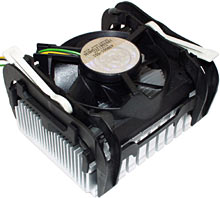


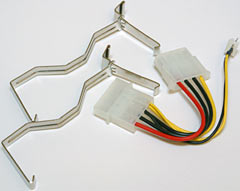


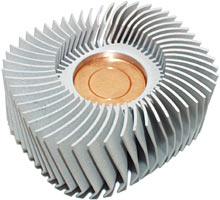


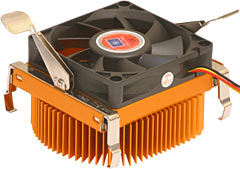

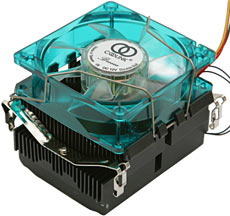
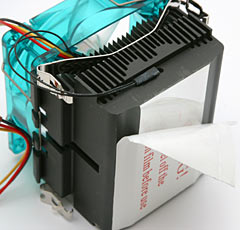
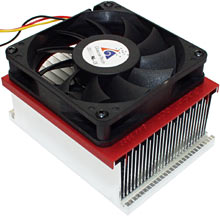

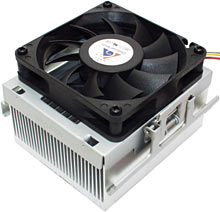
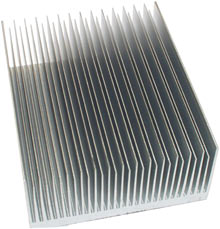
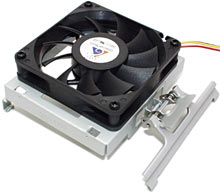
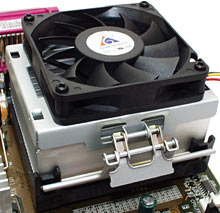


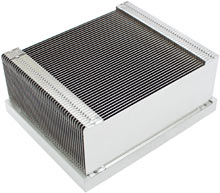
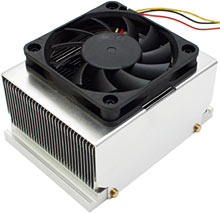
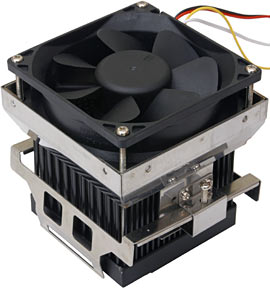
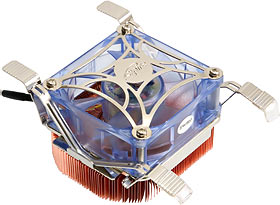
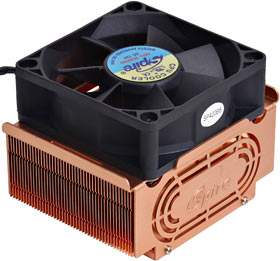
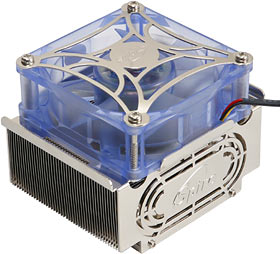
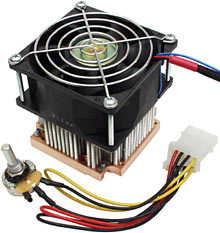
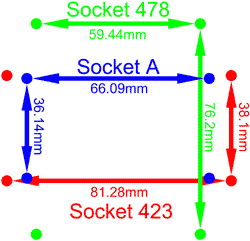
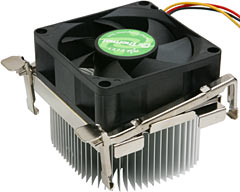
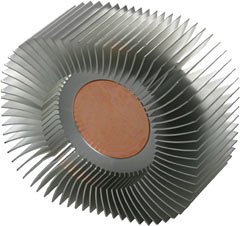
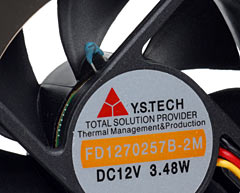

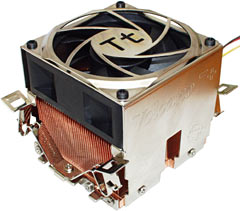

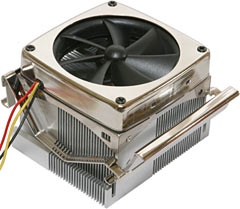




















![[SecureWebs]](images/sw.gif)